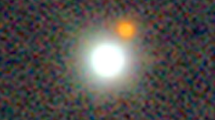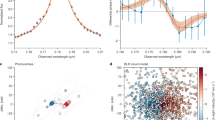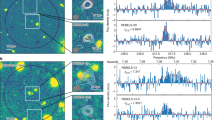Abstract
The most distant quasars known, at redshifts z ≈ 6, generally have properties indistinguishable from those of lower-redshift quasars in the rest-frame ultraviolet/optical and X-ray bands1,2,3. This puzzling result suggests that these distant quasars are evolved objects even though the Universe was only seven per cent of its current age at these redshifts. Recently one z ≈ 6 quasar was shown not to have any detectable emission from hot dust4, but it was unclear whether that indicated different hot-dust properties at high redshift or if it is simply an outlier. Here we report the discovery of a second quasar without hot-dust emission in a sample of 21 z ≈ 6 quasars. Such apparently hot-dust-free quasars have no counterparts at low redshift. Moreover, we demonstrate that the hot-dust abundance in the 21 quasars builds up in tandem with the growth of the central black hole, whereas at low redshift it is almost independent of the black hole mass. Thus z ≈ 6 quasars are indeed at an early evolutionary stage, with rapid mass accretion and dust formation. The two hot-dust-free quasars are likely to be first-generation quasars born in dust-free environments and are too young to have formed a detectable amount of hot dust around them.
This is a preview of subscription content, access via your institution
Access options
Subscribe to this journal
Receive 51 print issues and online access
$199.00 per year
only $3.90 per issue
Buy this article
- Purchase on Springer Link
- Instant access to full article PDF
Prices may be subject to local taxes which are calculated during checkout



Similar content being viewed by others
References
Fan, X. et al. A survey of z > 5.7 quasars in the Sloan Digital Sky Survey. III. Discovery of five additional quasars. Astron. J. 128, 515–522 (2004)
Jiang, L. et al. Gemini near-infrared spectroscopy of luminous z ∼ 6 quasars: chemical abundances, black hole masses, and Mg II absorption. Astron. J. 134, 1150–1161 (2007)
Shemmer, O. et al. Chandra observations of the highest redshift quasars from the Sloan Digital Sky Survey. Astrophys. J. 644, 86–99 (2006)
Jiang, L. et al. Probing the evolution of infrared properties of z ∼ 6 quasars: Spitzer observations. Astron. J. 132, 2127–2134 (2006)
Fan, X. et al. Constraining the evolution of the ionizing background and the epoch of reionization with z ∼ 6 quasars. II. A sample of 19 quasars. Astron. J. 132, 117–136 (2006)
Willott, C. J. et al. Four quasars above redshift 6 discovered by the Canada-France High-z Quasar Survey. Astron. J. 134, 2435–2450 (2007)
Kurk, J. D. et al. Black hole masses and enrichment of z ∼ 6 SDSS quasars. Astrophys. J. 669, 32–44 (2007)
Antonucci, R. Unified models for active galactic nuclei and quasars. Annu. Rev. Astron. Astrophys. 31, 473–521 (2003)
Elitzur, M. The toroidal obscuration of active galactic nuclei. N. Astron. Rev. 52, 274–288 (2008)
Rieke, G. H. The infrared emission of Seyfert galaxies. Astrophys. J. 226, 550–558 (1978)
Hyland, A. R. & Allen, D. A. An infrared study of quasars. Mon. Not. R. Astron. Soc. 199, 943–952 (1982)
Haas, M. et al. The ISO view of Palomar-Green quasars. Astron. Astrophys. 402, 87–111 (2003)
Richards, G. T. et al. Spectral energy distributions and multiwavelength selection of type 1 quasars. Astrophys. J. 166 (Suppl.). 470–497 (2006)
Glikman, E., Helfand, D. J. & White, R. L. A near-infrared spectral template for quasars. Astrophys. J. 640, 579–591 (2006)
Kurk, J. D. et al. Near-infrared spectroscopy of SDSS J0303–0019: a low-luminosity, high-Eddington-ratio quasar at z ∼ 6. Astrophys. J. 702, 833–837 (2009)
Ryan, C. J., De Robertis, M. M., Virani, S., Laor, A. & Dawson, P. C. The central engines of narrow-line Seyfert 1 galaxies. Astrophys. J. 654, 799–813 (2007)
Wang, R. et al. Millimeter and radio observations of z ∼ 6 quasars. Astron. J. 134, 617–627 (2007)
Wang, R. et al. Thermal emission from warm dust in the most distant quasars. Astrophys. J. 687, 848–858 (2008)
Hines, D. C. et al. Spitzer observations of high-redshift QSOs. Astrophys. J. 641, 85–88 (2006)
Neugebauer, G. et al. Continuum energy distributions of quasars in the Palomar-Green Survey. Astrophys. J. 63 (Suppl.). 615–644 (1987)
Haas, M. et al. Dust in PG quasars as seen by ISO. Astron. Astrophys. 354, 453–466 (2000)
Hernán-Caballero, A. et al. Mid-infrared spectroscopy of infrared-luminous galaxies at z ∼ 0.5–3. Mon. Not. R. Astron. Soc. 395, 1695–1722 (2009)
Vestergaard, M. & Peterson, B. M. Determining central black hole masses in distant active galaxies and quasars. II. Improved optical and UV scaling relationships. Astrophys. J. 641, 689–709 (2006)
Elvis, M., Marengo, M. & Karovska, M. Smoking quasars: a new source for cosmic dust. Astrophys. J. 567, 107–110 (2002)
Maiolino, R. et al. A supernova origin for dust in a high-redshift quasar. Nature 431, 533–535 (2004)
Stratta, G., Maiolino, R., Fiore, F. & D’Elia, V. Dust properties at z = 6.3 in the host galaxy of GRB 050904. Astrophys. J. 661, 9–12 (2007)
Shen, Y., Greene, J. E., Strauss, M. A., Richards, G. T. & Schneider, D. P. Biases in virial black hole masses: an SDSS perspective. Astrophys. J. 680, 169–190 (2008)
Barth, A. J., Martini, P., Nelson, C. H. & Ho, L. C. Iron emission in the z = 6.4 quasar SDSS J114816.64+525150.3. Astrophys. J. 594, 95–98 (2003)
Vestergaard, M. & Osmer, P. S. Mass functions of the active black holes in distant quasars from the Large Bright Quasar Survey, the Bright Quasar Survey, and the color-selected sample of the SDSS fall equatorial stripe. Astrophys. J. 699, 800–816 (2009)
Lavalley, M., Isobe, T. & Feigelson, E. in Astronomical Data Analysis Software and Systems I (eds Worrall, D. M., Biemesderfer, C. & Barnes, J.) 245–247 (ASP Conf. Ser. Vol. 25, Astronomical Society of the Pacific, 1992)
Acknowledgements
This work is based on observations made with the Spitzer Space Telescope, which is operated by the Jet Propulsion Laboratory, California Institute of Technology, under a contract with NASA. Support for this work was provided by NASA through an award issued by JPL/Caltech. X.F. acknowledges support by NSF AST, a Packard Fellowship for Science and Engineering, and a John Simon Guggenheim Memorial Fellowship. W.N.B. was supported by the NASA ADP program. C.L.C. thanks the Max-Planck-Gesellschaft and the Humboldt-Stiftung for support through the Max-Planck-Forschungspreis. J.D.K. thanks the DFG for support via German-Israeli Project Cooperation. The Dark Cosmology Centre is funded by the Danish National Research Foundation.
Author Contributions L.J. and X.F. designed the project, reduced and analysed the data, and prepared the manuscript; W.N.B., M.A.S. and F.W. performed statistics and edited the manuscript; C.L.C., E.E., D.C.H. and G.T.R. prepared observations; J.D.K. analysed NIR spectra of two hot-dust-free quasars; Y.S. and M.V. measured black hole masses. All authors helped with the scientific interpretations and commented on the manuscript.
Author information
Authors and Affiliations
Corresponding author
Ethics declarations
Competing interests
The authors declare no competing financial interests.
Rights and permissions
About this article
Cite this article
Jiang, L., Fan, X., Brandt, W. et al. Dust-free quasars in the early Universe. Nature 464, 380–383 (2010). https://doi.org/10.1038/nature08877
Received:
Accepted:
Issue Date:
DOI: https://doi.org/10.1038/nature08877
This article is cited by
-
Active galactic nuclei: what’s in a name?
The Astronomy and Astrophysics Review (2017)
-
A possible influence on standard model of quasars and active galactic nuclei in strong magnetic field
Astrophysics and Space Science (2016)
-
Dust in the IGM: pro and contra
Astrophysics and Space Science (2011)
-
First generation of quasars
Nature (2010)
Comments
By submitting a comment you agree to abide by our Terms and Community Guidelines. If you find something abusive or that does not comply with our terms or guidelines please flag it as inappropriate.



